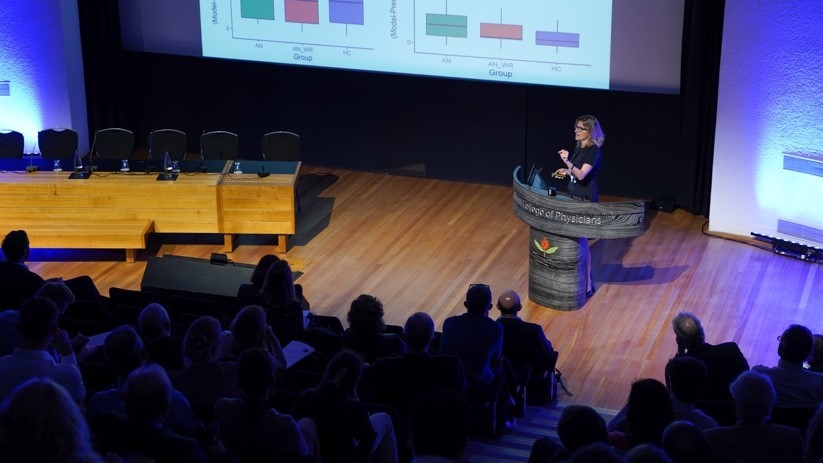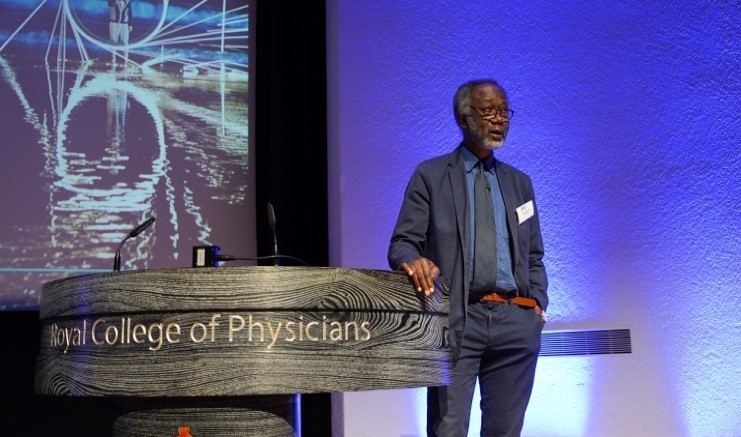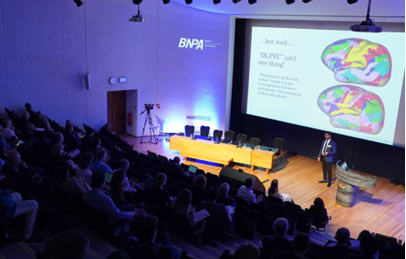This year’s 35th BNPA Annual Conference took place on the 26th and 27th May, our first in-person meeting since 2019. It was held in the Royal College of Physicians’ iconic building on Regent’s Park, described as a “modernist masterpiece.”
Hundreds of neurologists, psychiatrists and psychologists journeyed in, brightened by the sun, whilst many more joined virtually.
Along with our usual BNPA Medal Award and JNNP Plenary Lecture, this year’s themes included:
- Medicolegal aspects of neuropsychiatry
- Inflammation
- Neuromodulation
- Neuropsychiatry of Interoception
Day 1 started with the very entertaining BNPA medal lecture on Neuropsychiatry Mavericks by Professor Anthony David, a BNPA former chair and founding member, and Director of the UCL Institute of Mental Health, UK. Professor David guided us through a 150-year history of neuropsychiatry mavericks. Along the way he highlighted the key characteristics common to the maverick’s personality type and explored the significance in the modern age.

Then Dr Christopher Bass opened the session on Medicolegal aspects of neuropsychiatry. He highlighted the behavioural spectrum that falls under the controversial and often misused term “malingering.” Within this context, Dr Bass covered the challenges of revealing the degree of symptom exaggeration/amplification in mild Traumatic Brain Injury (mTBI) and Functional Neurological Disorder (FND). He focused on the importance of establishing a chronology from multiple sources, but also on the importance of an awareness of the iatrogenic contribution to symptom perpetuation.
Professor Alan Carson then spoke about FND in the context of personal injury, covering diagnosis, symptom exaggeration, onset, risk and triggers and treatment, and described his approach in helping the court decide on the sequence of events and where might lie the blame.
After refreshments, Dr Virginia Newcombe, Consultant in Neurosciences and Trauma Critical Care Medicine, and Emergency Medicine, challenged common beliefs about TBI and delved into the world of post-concussion symptoms. Dr Newcombe enlightened us on what’s new in mTBI, highlighting the importance of pre-injury factors in symptom development, as well as describing how common post-concussion symptoms (e.g. headache, dizziness and fatigue) are in the general population.
At midday Dr Quinton Deeley, Consultant Psychiatrist and Senior Lecturer in Social Behaviour and Neurodevelopment (and with a previous BA in Theology and Religious Studies) gave a thought-provoking talk about free-will and criminal responsibility. He explored both philosophical and neuropsychiatric insights in the control of behaviour; how these can be impaired and the implications for notions of criminal responsibility. A memorable example was a case of kleptomania after frontal lobe injury, where the patient was aware that their actions were wrong but was nevertheless unable to prevent his own stealing.
Following lunch, the data blitz sessions took place against the enchanting backdrop of the Dorchester library, housing one of the most significant collections of rare books in the world. Tea, coffee and desserts were served whilst digital poster presentations (available now on the BNPA website were streamed, each 3 minutes in length, followed by quick-fire Q&As with the authors. Posters were of an excellent standard and covered a wide range of topics, with the poster prize winners announced shortly after:
- Heather Smyth - ‘In a mist?’ – What is ‘brain fog’?
- Isabel Mason - Functional neurological disorder in the chronic pain clinic; a retrospective study of comorbidity
- Saurabh Sonkusare - Frequency dependent emotion differentiation and directional coupling in amygdala, orbitofrontal and medial prefrontal cortex network with intracranial recordings
Dr Wendy Phillips, BNPA Director, finished the theme with Medicolegal Clinical Case Presentations, accompanied by fellow Consultant Neurologist Dr Mark Manford, who gave a talk on epilepsy (and associated TBI), with the thought provoking statistic that 20% of patients at tertiary clinics with the diagnosis of “uncontrollable epilepsy” do not have epilepsy. The audience were treated to an exciting panel discussion with Professors Jon Stone and Michael Kopelman, BNPA Secretary Dr Vaughan Bell, and barristers Jonathan Dingle and Andrea Barnes. We enjoyed both clinical and legal interpretations and perspectives of the cases, not always in agreement, but certainly backed with solid argument, whilst offering our own thoughts via the Slido App.
Then began the theme around our so-called hidden sense: interoception. The audience received a boost of post-prandial energy from the riveting and enthusiastic talk by Professor Sarah Garfinkel on “Dissociating dimensions of interoception in neuropsychiatry.” Shining light on the interoceptive channel from the heart, Professor Garfinkle spoke about how afferent signals interact with neuronal mechanisms to alter emotion processing, but also how this is disrupted in neuropsychiatric conditions, impacting symptoms such as dissociation and anxiety. A highlight of the talk was the exciting data showing how interoceptive training for autistic people might alleviate anxiety through improved bodily awareness.
We then delved into “the self” and interoception with Professor Aikaterini Fotopoulou’s invigorating talk on “Integrating dimensions of interoception in neuropsychiatry.” Thought provoking to say the least, Professor Fotopoulou discussed interoceptive monitoring difficulties in anorexia nervosa. The relevance here is belief updating and how rigid behavioural control might be used to resolve the intolerable uncertainty of interoceptive states in anorexia nervosa. Interoceptive therapies using biofeedback offered future hope within this area.
Our keynote talk of the day was by renowned author and Professor of Cognitive Neuroscience Adrian Owen OBE, titled “Into the Gray Zone: Assessing Residual Cognitive Function after Serious Brain Injury”. Professor Owen described how the use of fMRI, EEG and functional near-infrared spectroscopy (fNIRS) can be used to detect covert conscious awareness in patients who are behaviourally entirely non-responsive, allowing some of these individuals to communicate their wishes and thoughts. Professor Owens also highlighted circumstances in which imaging cannot be used to infer awareness, enlightening us both clinically and neurophilosophically on the neural representation of our own thoughts and intentions.
Thursday evening ended with a pizza and drinks party, accompanied by the superb vocal harmonies of four-piece band The Party Faithful in the gardens of the Royal College.

Day 2 began with the unforgettable, captivating and slideless JNNP lecture by Honorary Professor of Psychiatry at the University of Birmingham, UK, Femi Oyebode, whose introduction was inspiring in itself. Professor Oyebode guided us through the descriptive psychopathology of phantom limb, Charles Bonnet, musical hallucinations and autoscopy (carefully differentiating the feeling of presence, negative autoscopy, out of body experience and heautoscopy proper) and along the way inferred underlying brain processes. Professor Oyebode emphasised the value of psychopathology in theorising about neural mechanisms: “To be constantly interested in psychopathology, asking the right questions which are not there in checklists, matters as it also reveals so much more about how the brain works.”
Then began the theme of inflammation, with a historical but also contemporary talk by Dr Mark Honigsbaum on “What can we learn from the nervous sequelae of past pandemics”. Dr Honigsbaum examined the Victorian approach to the nervous sequalae trailing the “Russian influenza” of the 1890s, such as exhaustion and psychosis, which, unlike long-COVID, were more often documented in men than women.
Next, Professor Michael Benros (Head of Research at Mental Health Centre Copenhagen, Denmark) spoke about “The epidemiology of infections as a risk factor for psychiatric illness,” opening with a chronology of psychoneuroimmunology, from 400BC to present day. Using Danish registry and biobank data he showed how infections and autoimmune diseases increase the risk of developing severe mental disorders in a dose-response relationship. He also boosted our knowledge of the immunogenetic contribution to this and the recognition of the role of anti-inflammatories for neuropsychiatric sequelae.

The morning was rounded off by three 15 minute members’ platform talks; Dr Samia Elkommos (Dept of Neuroscience, Kings College, UK), Alicia Smith (PhD student at University of Cambridge, UK) and Dr Hailun Cui (Dept of Psychiatry, University of Cambridge, UK). Dr Elkommos brought together depersonalisation and altered interoceptive processing with the heartbeat-evoked potential (HEP) in her talk on “Attenuated heart-brain integration predicts functional non-epileptic seizures,” raising the HEP as a potential biomarker for functional seizures. Alicia Smith enriched our knowledge of memory with her presentation on “Aberrant emotional memory encoding in a transdiagnostic sample of patients with intrusive memories,” showing how individuals with intrusive memories experienced greater sensitivity to negative stimuli and going on to report on the role of attention in this.
Dr Cui’s presentation on the neuropsychological changes underlying the symptomatic relief in capsulotomy for refractory OCD, reported (using task-based fMRI) the importance of targeting connectivity between the nucleus accumbens and pregenual anterior cingulate cortex.
Following the BNPA AGM was another superb lunchtime data blitz, with Friday’s winners:
- Laura Marsh - Inhibition of personal memory retrieval in dissociative amnesia: a study of two cases
- Tanmay Anand - Object drawing from name in semantic dementia provides evidence for graded, transmodal semantic knowledge
Our afternoon theme of neuromodulation commenced with a joint session with the American Neuropsychiatric Association, in which Dr Shan Siddiqi (Neuropsychiatrist and Asst Professor at Harvard Medical School and Brigham Women’s Hospital, US), gave an outstanding plenary talk on circuit-based targeting of brain stimulation treatments (such as TMS and DBS). He illustrated how neuromodulation can target different circuits for different symptoms (e.g. dysphoric vs somatic symptoms), but also how TMS and DBS can target the same circuit to treat the same depressive symptom, and how lesions can be used to identify TMS and DBS targets. The importance of personalised brain mapping in neuromodulation was highlighted in the treatment of psychiatric disorders.
In BNPA President Professor Valerie Voon’s talk, titled “Neuromodulation of intracranial physiological recordings and behaviour,” we were presented with illuminative studies indicating the physiological networks underlying negative emotional processing, anticipation of reward and loss, and risk taking. Professor Voon also showed how stimulation at specific frequencies might influence behavioural measures, and instilled therapeutic optimism with ways of refining neuromodulation parameters when treating related disorders.
Professor Colleen Hanlon closed the show with her talk titled “Saving Adam from the Apple: using transcranial magnetic stimulation as a transdiagnostically relevant tool to decrease cue-reactivity”. Professor Hanlon bridged the worlds of neuromodulation and temptation with a transdiagnostic neural biomarker for cue reactivity: a network involving the ventral medial prefrontal cortex (vmPFC), anterior cingulate cortex (ACC), and insula. We were shown how continuous theta burst stimulation to the left frontal pole decreases drug cue-reactivity among heavy alcohol users and cocaine users. This also decreased frontal connectivity in this network and has been shown to reduce cue reactivity in PTSD and obsessive behavioural disorders.
The conference ended with a well-deserved and sustained round of applause and show of gratitude for our Executive Administrator Jackie Ashmenall and Conference Secretary Gwen Cutmore.
The next BNPA AGM will be held at the Royal College of Physicians, on the 2nd and 3rd of March 2023.
The poster presentations can be viewed at bnpa.org.uk/2022-poster-gallery/ and the majority of the videos of the talks from the BNPA 2022 annual conference will be uploaded to http://www.bnpa.org, along with the abstracts.